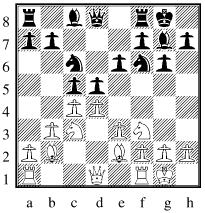
January 2016

|
| RR v Anon after 9 d4 |
The position shown can readily be reached by a variety of move orders, and occurred in one of RR's games at the Santa Handicap a couple of nights ago. White has an unprotected bishop on b2, and black sees the opportunity of using this to create a pin:
9 ... cxd4, 10 Nxd4 Ne4, 11 Nxe4 dxe4 reaching diagram right
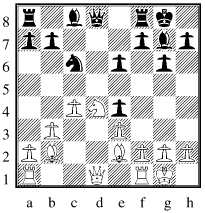
|
| RR v Anon after 11 ... dxe4 |
13 Ne7+ Kh8, 14 Bxg7+ Kxg7, 15 Raxd1
With white's rook covering d7, black cannot prevent a further exchange of minor pieces, and white emerges a full piece up, with control of the d-file and a slightly better pawn structure thrown in too.
comment on this article
Division 1
| ||||||||||||||||||||||||||||||||||||||||||||||||
Division 3
| ||||||||||||||||||||||||||||||||||||||||||||||||
Division 5
|
Division 2
| ||||||||||||||||||||||||||||||||||||||||||||||||
Division 4
|
With the season about to restart following the Christmas break, it is time to consider progress so far. All the league teams are now off the mark; indeed only Fenton C have just one point. With much dog eat dog going on in the various divisions, points on the board will often prove more useful than matches in hand, but with one exception - Fenton D - no side has yet established more than slight favourate status in their division.
But for a postponement the first division would have reached the halfway point in its 2015/16 life. It may be small, but it certainly looks unpredictable, with every match of potential significance.
Following a slow start to life in division two the A teams of both Crewe and Fenton have picked up enough to maintain contact with the second division regulars. At the business end of the table Cheddleton C have a small advantage - will it be stretched or erased in the coming weeks?
The November/December honours in division three were shared by Cewe B and Newcastle D who both won all three of their matches in this period. Kidsgrove were pointless over the same period, though I'm sure I could express that better.
Cheddleton F remain on top of the fourth, and although there has been some churn in the central placings, the wrong end is still populated by Newcastle and Fenton C, who are both a little adrift. Should their clash on the 18th be regarded as a wooden spoon four-pointer?
Fenton D have established themselves as the team to stop in division five, having dropped just one point so far. With all the others having dropped at least five, they now have quite an advantage.
The delayed open cup match went Stafford's way (boo!), whilst in the last match before Christmas, Meir progressed in the Perry cup with their A team beating their B.
The Doubles returned after a one year absence, with Colin Davison & Phil Cattermole and Stuart Hull & Mike Smith respectively winning the 320 and 230 sections, whilst David Price won the first North Staffs Santa Handicap.
January looks like a busy month, weather and flu epidemics permitting. Maybe a few more teams will be putting their heads above the parapets as favourites for their competitions by then.
comment on this article
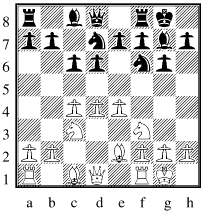
|
| RR v John Booth after 7 ... c6 |
Shoving the e-pawn whilst I still have a chance and before John has time to unwrap his pieces is the attractive idea, but my thoughts are too shallow to see that I can, with said thoughts going as far as
8 e5 dxe5, 9 dxe5 Ng4 with multiple attacks on my e-pawn. Shoving again would encourage him to gain doubled isolated e-pawns in exchange for the pawn he wins, but would allow him the f6 square back for his knights. Shoddy thinking. Play could then continue
10 e6 fxe6, 11 Ng5 threatening Nxe6 forking queen and rook, and revealing a double attack on the g4 knight, after which black's best hope is perhaps Nxf2 hoping that white goes wrong in the subsequent craziness. Thus the line I'm afraid of after e5 is one I should want! Instead timidity reigns:
8 h3 Qc7 and the e5 advance is no longer available. Guess I should be thankful for small mercies that John didn't play e5 himself.
9 Bf4 If rooks go on the same file as the enemy queen I guess bishops belong on the same diagonal.,br>
9 ... e5, 10 Bh2 Nh5, 11 Qd2 a6, 12 d5 a cowardly play, offering the chance to lock the centre, which John accepts. Removing the a-rook from the firing line of the g7 bishop is an obviously sane move, even though my silicon friend tells me that c5 is best.
12 ... c5
Having blocked the centre and placed a knight on an annoying square on the queenside it seems clear that attention will switch to the opening of the f-file. Unfortunately RR decides to make some preparatory moves first, giving black the time to unravel his position.
13 Rab1 a5, 14 Nb5 Qb8, 15 Rbe1 Nb6, 16 g4 Nf6
17 Nc3 Bd7, 18 Nh4 Qd8, 19 Bg3 Ne8 reaching the position right.
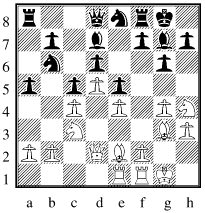
|
| RR v John Booth after 19 ... Ne8 |
21 Bf2 g5, 22 Nf3 (Nf5 surely better) 22 f6 John chooses to consolidate his pawn win rather than going for the more aggressive immediate h5.
23 Kg2 with vague ideas of Rh1 and opening the h-file myself
23 ... Nc8, 24 Qd3 eying h7
24 ... Ne7, 25 e5 fxe5, 26 Nxg5 Ng6 diagram left
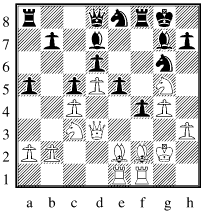
|
| RR v John Booth after 26 ... Ng6 |
27 ... Qe7 Phew. I'm not the only one who goes wrong.
28 Bf3 Nf6, 29 Ne6 Nxe4, 30 Bxe4 Rf6, 31 g5 Rxe6
32 dxe6 Qxg5+, 33 Kh2 Bxe6 diagram right
Black has three pawns for the exchange, but white has both Bxb7 and Qxd6 available. Amazingly such is the state of RR's brain that he fears Rd8 after Qxd6 even though white would then have the small matter of Qxe6 available to him, and Rb8 after Bxb7, even though the bishop can retreat to d5 denying the rook time to capture on b2.
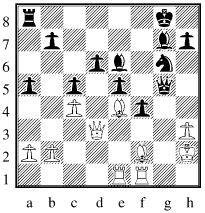
|
| RR v John Booth after 33 ... Bxe6 |
35 ... hxg6, 36 h4 Qf5, 37 Rd1 e4, 38 Qf1 Be5
39 Rg5 Qf6, 40 Qg1 Kf7, 41 Bxc5 f3+, 42 Kh1 dxc5
43 Qxc5 Bf4, 44 Rdg1 Rh8, 45 h5 Bxg5, 46 Rxg5 Qxg5 0-1
In summary, RR was given chances to open the centre, but didn't.
He then blundered his f-pawn.
John was given the chance to play the material winning f3+, but didn't.
John gives up the exchange for two pawns.
RR fails to grab the d or b-pawns.
RR makes an ill-judged exchange of minor pieces.
John shows why the bishop pair is so good.
comment on this article
We join the game after seven moves, and although the move order was different, the position is remarkably similar to the one in RR's last game above. However Bill's seventh move denies RR the opportunity to shove his e-pawn for early effect.

|
| RR v Bill Armstrong after 7 ... e5 |
9 h3 Nxe3, 10 fxe3 Bh6 11 Qd3 Queens aren't made to defend pawns, but what else to do?
11 ... c5, 12 Nd5 Bg7, 13 Rad1 f5 An unexpected reprieve for his pawns; RR had expected to have to play a substantial part of the games working around his dubious central structure. One of his doubled pawns goes, and things become more fluid.
14 exf5 gxf5, 15 dxe5 Nxe5, 16 Qd2 Nf7
17 Nf4 Bd7, 18 b3 a5
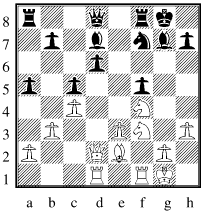
|
| RR v Bill Armstrong after 18 ... a5 |
19 Qd5 a4, 20 b4 (isn't Bd3 the logical continuation?)
20 ... cxb4, 21 c5 Ra5 RR realizes that not only does his cunning plan to win the d-pawn and/or pressure the bishop behind it not work, but that aided by his major pieces and dark-squared bishop Bill's queeenside pawns could march to victory. Time to reduce their number:
22 Qxb7 Rxc5, 23 Qxb4 Bc3 24 Qb1 Qa5
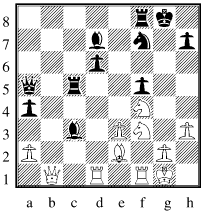
|
| RR v Bill Armstrong after 24 ... Qa5 |
25 Nd4 Re5, 26 Qb7 Bc8, 27 Qf3 Kh8 Safety first, or clearing g8 for the rook?
28 Qh5 Rxe3, 29 Ng6+ Kg7, 30 Nxf5+ Bxf5, 31 Nxf8 1-0, Bill's flag falling whilst trying to sort out the best continuation. Or possibly the least bad.
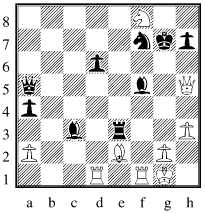
|
| RR v Bill Armstrong final position |
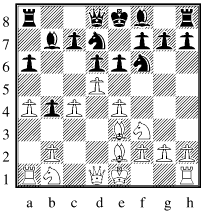
|
| RR v Ian Jamieson after 8 ... Ng8f6 |
12 ... Ngf6, 13 O-O Nc5, 14 Bf3 a5, 15 dxe6 fxe6, 16 e5 It is around here that I found the options began to become too many to keep proper track of. A half-open f-file, bishops looking at each other on the long diagonal, black king in the centre, doubled isolated pawns in front of the king if black recaptures. No surprise that the subsequent play deviates from Stockfish's recommendation of best.
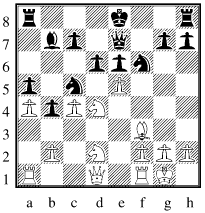
|
| RR v Ian Jamieson after 16 e5 |
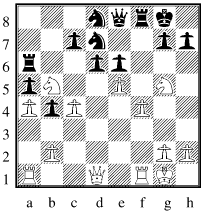
|
| RR v Ian Jamieson after 23 Nb5 |
26 ... Nf6, 27 Nge4 ... then rescue the knight, though Rad1 probably better - bringing another piece into the game is surely not wrong.
27 ... Nf7, 28 Nxf7 Qxf7, 29 Rad1 Nxe4, 30 Qxe4 Qa7+, 31 Kh1 Qc5
Thinking endgame now - a juicy passed pawn and control of the central files on which I must surely be able to arrange the exchange of at least some major pieces. Just don't fall for a back row mate.
32 b3 Rd6, 33 Rxd6 Qxd6, 34 g3 h6, 35 Re1 Kf7, 36 f5 exf5
37 Qxf5+ Kg8, 38 Qxa5 Kh7, 39 Qd5 1-0
comment on this article
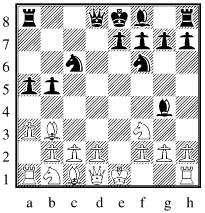
|
| Ian Bates v RR after 9 Nc3 |
10 ... Kxf7, 11 Ne5+ Ke8, 12 Nxg4 Nxg4, 13 Qxg4 Nxb4 and white has three pawns for the piece. Instead Ian plays for the attack, declaring his a-rook redundant.
13 ... Nxc2+, 14 Kd1 Nxa1, 15 Qh5+ g6, 16 Qe5 Qd7 Another rook declared redundant.
17 Qxh8 Qg4+, 18 Ne2 Rc8, 19 Qe5 Qa4+, 20 Ke1 Nc2+
21 Kf1 Qc4 RR can win the exchange with Ne3+, but his queen will be out of play and a draw by repetition would loom as he couldn't escape checks without giving up his own rook to be a piece and two pawns down. Perhaps there were better ways of playing this attack (yes says the computer), but at least I retain some sort of edge, and am threatening Nd4, and defending these wild positions is not always any easier than handling the attacking side.
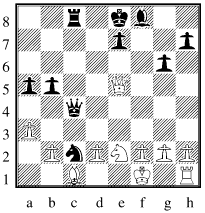
|
| Ian Bates v RR after 21 ... Qc4 |
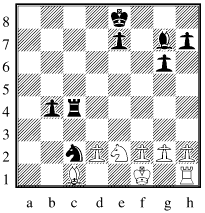
|
| Ian Bates v RR after 27 ... Bg7 |
31 Bxb2 Bxb2, 32 g4 Ra6, 33 h5 Ra1+, 34 Kg2 Ne1+
35 Kh2 g5, 36 f4 gxf4, 37 Nxf4 Be5 Ians's only real chance is to get a dangerous passed pawn, but his attempts run into the sand.
38 Kg3 Nxd3, 39 Kh4 Nxf4, 40 Rb3 h6, 41 Rb6 Rh1+ 0-1
With the rook about to die too Ian has had enough.
comment on this article